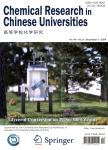Disulfide-crosslinked Poly(L-glutamic acid) Grafted Mesoporous Silica Nanoparticles and Their Potential Application in Drug Delivery
Disulfide-crosslinked Poly(L-glutamic acid) Grafted Mesoporous Silica Nanoparticles and Their Potential Application in Drug Delivery作者机构:Department of Chemistry Nanchang University Nanchang 330031 P. R. China State Key Laboratory of Molecular Engineering of Polymers Department of Macromolecular Science Fudan University Shanghai 200433 P. R. China
出 版 物:《Chemical Research in Chinese Universities》 (高等学校化学研究(英文版))
年 卷 期:2015年第31卷第5期
页 面:890-894页
核心收录:
学科分类:081703[工学-生物化工] 081704[工学-应用化学] 08[工学] 0817[工学-化学工程与技术] 081701[工学-化学工程] 0836[工学-生物工程] 082203[工学-发酵工程] 0822[工学-轻工技术与工程]
基 金:Supported by the National Natural Science Foundation of China(Nos.51203073 51463013 51263017) and the Natural Science Foundation of Jiangxi Province China(Nos.20142BAB203018 20151BAB206011)
主 题:Mesoporous silica nanoparticle Redox responsive Drug delivery Surface modification Hybrid
摘 要:Poly(L-glutamic acid)(PLGA) was grafted onto the surface of mesoporous silica nanoparticles(MSN) via the ring opening polymerization of γ-benzyl-L-glutamate N-carboxyanhydride(BLG-NCA) and its subsequent deprotection of benzyl groups. The PLGA chains were cross-linked with cystamine, and thus forming a type of redox responsive drug delivery system(MSN-cPLGA). The structures were characterized by Fourier transform infrared spectrometry(FTIR), transmission electron microscopy(TEM) and energy disperse spectrometry(EDS), demonstrating that disulfide groups existed on the surfaces of MSN-cPLGA particles. The thermal gravimetric analysis(TGA) results show that the PLGA mass fraction is about 33.4% in the MSN-cPLGA hybrid. The in vitro drug release experiments showed that the MSN-cPLGA hybrid can realize the controlled release of model drugs(5-fluorouracil) in response to redox environment. Even 0.1 mmol/L dithiothreitol(DTT) can accelerate the drug release speed, and a concentration of 10.0 mmol/L DTT is higher enough to trigger the open of cross-linked PLGA network so as to realize rapid release of drugs. All the results demonstrate that the cross-linked PLGA chains on the surface of MSN could act as efficient gatekeepers to control the on-off of the pores, showing potential application in drug delivery system.



